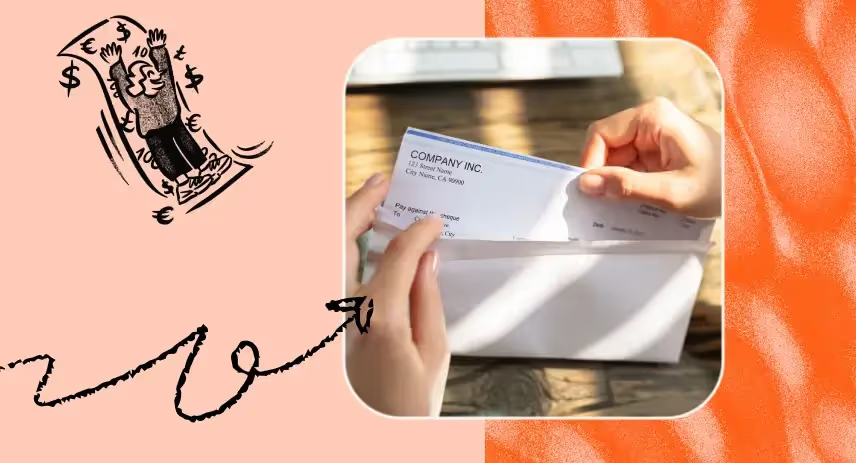Freelancers and independent contractors enjoy the freedom to work on their own terms, choosing projects that meet their personal and financial goals. Contract work also benefits businesses, which can tap into a pool of self-employed workers to address specific needs without the commitment and cost of a full-time employee.
However, this non-traditional work relationship requires a business to take extra care with administrative tasks, especially tracking pay stubs. Traditional employees receive pay stubs detailing their net pay, earnings, and tax deductions. Independent contractors are responsible for their own payroll and tax forms. They submit invoices to clients, track payments received, and document important information for tax day.
In this guide, we’ll explore what a pay stub is and why independent contractor pay stubs are essential for gig workers and clients alike. We’ll show you how to generate them and provide tips for keeping them organized.
Employees vs. independent contractors
Regular employees and independent contractors differ enormously in their work arrangements and obligations. Here’s a quick overview of the critical distinctions regarding pay:
- Taxes: Employers withhold taxes from their employees’ paychecks. Employers in the United States also contribute to Social Security, Medicare, and unemployment insurance. Independent contractors are responsible for managing their own self-employment taxes, including covering the entirety of their Social Security and Medicare taxes.
- Payroll: Employees receive regular paychecks with detailed pay stubs that outline their net pay, earnings, and tax deductions. In contrast, independent contractors submit invoices to clients and handle their own payroll, tracking payments and expenses independently.
- Tax forms: U.S. employees receive a W-2 form from their employer at the end of the year, which summarizes their earnings and tax withholdings. Independent contractors receive a 1099-NEC form from each client, which reports the total payments received during a specific tax year. The 1099-NEC doesn’t detail individual payments and deductions.
What are independent contractor pay stubs?
A pay stub (aka a paycheck stub or payslip) is a detailed record that outlines an employee’s pay, tax information, and other compensation for a specific pay period. Traditional employees typically receive pay stubs along with their paychecks to provide transparency about their wages and tax withholdings. Paystubs also simplify payroll management and tax reporting for employees and employers alike.
So, do 1099 employees get pay stubs from their clients? No—but 1099 employees can generate pay stubs independently with a pay stub template. Self-generated pay stubs document essential details like hours worked, wages, and relevant deductions. They help contractors maintain accurate records of their earnings to manage finances, project their annual salary, and pay taxes. Additionally, detailed documentation of annual pay comes in handy when applying for loans, health insurance, or other financial services that require proof of income.
Elements of an Independent Contractor pay stub
A detailed self-employed pay slip helps contractors record wages, track payments received, and make tax filings with the IRS. Here are six items to include:
- Personal information: The contractor and client’s name, address, and contact details. This information clearly identifies both parties involved in the business transaction.
- Gross income: The total amount earned before any deductions. This clearly calculates total earnings for the project or pay period.
- Pay rate: The agreed-upon rate for the contracted services, which might be an hourly wage or a fixed amount per project. Thorough documentation of the pay rate verifies that payments align with the terms of the contract.
- Working hours: If payment is hourly, the pay stub should include the number of hours worked for the pay period. If the contractor works on multiple tasks or projects, breaking the hours into specific line items provides more clarity. A detailed breakdown helps ensure transparency, accurate compensation, and improved estimates for future projects.
- Expenses: Materials, supplies, travel, and any other agreed-upon expenses.
- Current total: The total amount due for the pay period, calculated by multiplying the pay rate by the number of hours or adding fixed amounts for completed projects.
- Deductions: Although contractors typically handle their own tax payments, they may include deductions on payslips to manage their tax liability. They could owe federal income tax, state income tax, social security tax, and Medicare tax. Statutory employees with withheld FICA taxes should also include deductions for Medicare and Social Security taxes.
How to generate a pay stub for an independent contractor in 6 steps
Self-employed workers should create pay stubs to document details about work and payment after each pay period or project. A 1099 pay stub example from a template or pay stub generator will help you generate your own pay stubs. Here’s how:
- Pick a pay stub template: Choose a clear and intuitive pay stub template. It should include a header with space for relevant contact information, a table to input completed tasks and corresponding wages, and a footer to input payment details and deductions.
- Double-check information: Inaccurate information can lead to payment delays, record discrepancies, and difficulty resolving legal issues. Verify the information is correct before submitting a pay stub to a contractor or employer. To avoid privacy risks, contractors shouldn’t include their full social security number on each pay stub.
- Calculate earnings information: Fill out your gross income (including rates, hours worked, or fees per deliverable) and the current total. Calculate appropriate deductions and the current year-to-date values for the specific client.
- Specify payment information: For clarity, include the agreed-upon pay period, pay date, payment schedules, and preferred payment method.
- Distribute the pay stub: Download your independent contractor pay stub in an agreed-upon format. Send a copy to accounts payable and store another in an accessible and secure folder. Name invoices numerically and organize them in folders for specific clients or contractors.
Meticulous formatting and organization will minimize risk for all parties involved. Fortunately, modern payroll solutions can do much of the heavy lifting.
Why is it important to track independent contractor pay stubs?
Independent contractors don’t have payroll and administrative departments to aid their financial management. Meticulous records of earnings and expenses will make filing tax forms easier and contribute to better overall financial health.
Here are some key benefits of solid record-keeping habits:
- Financial transparency and accountability: Pay stubs provide both contractors and employers with a clear record of payments, earnings, and deductions. Financial transparency promotes trust, organization, and accountability.
- Dispute resolution: Businesses and contractors may disagree about payment or hours worked. They can check stubs to resolve problems quickly and fairly.
- Proof of income: Loan applications, property rentals, health insurance, and other financial services require proof of income. Detailed pay stubs and income statements (alongside annual income tax returns) demonstrate financial stability and consistent earnings.
- Efficient financial management: Accurate pay stubs help employers pay independent contractors, track payments, and manage payroll budgets. Organized records also simplify financial management and tax reporting for contractors.
Oyster simplifies independent contractor management
Handling independent contractor pay stubs and payroll doesn’t have to be a challenge, even when balancing dozens of global contractors and projects. Oyster’s automated payroll solutions eliminate the hassle of generating and tracking independent contractor pay stubs, helping your organization streamline administrative tasks and focus on nurturing a strong, distributed team.
Learn how Oyster can help you stay organized, save time, and avoid the complexities of manual payroll management. Check out our global contractor service today.

About Oyster
Oyster is a global employment platform designed to enable visionary HR leaders to find, engage, pay, manage, develop, and take care of a thriving distributed workforce. Oyster lets growing companies give valued international team members the experience they deserve, without the usual headaches and expense.
Oyster enables hiring anywhere in the world—with reliable, compliant payroll, and great local benefits and perks.
.avif)



.avif)
.avif)
.avif)

.avif)
.webp)




_Leader_Leader%201%20(2)%20(3).svg)
_Leader_UnitedKingdom_Leader%201%20(1).svg)
_Leader_Europe_Leader%201%20(1).svg)
_Leader_Mid-Market_Leader%201%20(1).svg)
_Leader_Small-Business_Europe_Leader%202%20(2).svg)
_Leader_Small-Business_Leader%201%20(1).svg)
_FastestImplementation_Small-Business_GoLiveTime%201%20(1)%20(1).svg)